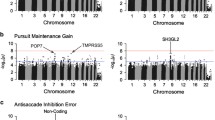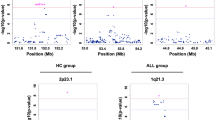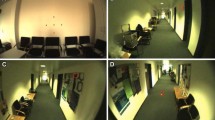Abstract
There is increasing evidence that the genetic predisposition for schizophrenia in families affects more individuals than those fulfilling the criteria for schizophrenia. This finding is supposed to be one of the major problems in molecular genetic schizophrenia research, especially when linkage studies are employed. Eye-tracking dysfunction (ETD), which is conceived as a possible phenotypic marker for genetic liability to schizophrenia, may offer considerable advantages. However, there is only little information from families with multiple occurrence of schizophrenia. It is still unclear whether in these families ETD aggregates with diagnoses from the schizophrenia spectrum. This first report from an ongoing study presents the results of 48 individuals from 6 multiplex families. Smooth-pursuit eye movements were recorded by infrared reflectometry and assessed by quantitative measurement techniques. Along with the high degree of psychiatric morbidity in these families, in 56.3% of the individuals ETD was assessed. Reduced mean pursuit gain was present in 39.6%. The distribution of eye-tracking dysfunction resembles the distribution of schizophrenia-related psychiatry morbidity.
Similar content being viewed by others
References
Abel LA, Ziegler S (1988) Smooth pursuit eye movements in schizophrenics—what constitutes quantitative assessment? Biol Psychiatry 24:747–761
Abel LA, Levin S, Holzman PS (1992) Abnormalities of smooth pursuit and saccadic control in schizophrenia and affective disorders—minireview. Vision Res 32(6):1009–1014
Arolt V, Steege D, Nolte A (1993) Störungen der Augenbewegungen bei Schizophrenen-Kritische Übersicht und zukünftige Perspektiven. Fortschr Neurol Psychiatrie 61:90–105
Blackwood DHR, St. Clair DM, Muir WJ, Duffy JC (1991) Auditory P300 and eye tracking dysfunction in schizophrenic pedigrees. Arch Gen Psychiatry 48:899–909
Cardno AG, McGuffin P (1994) The molecular genetics of schizophrenia. Neuropathol Appl Neurobiol 20:344–349
Clementz BA, Sweeney JA (1990) Is eye movement dysfunction a biological marker for schizophrenia? A methodological review. Psychol Bull 108:77–92
Clementz BA, Sweeney JA, Hirt M, Haas G (1991) Phenotypic correlations between oculomotor functioning and schizophrenia-related characteristics in relatives of schizophrenic probands. Psychophysiology 28:570–578
Clementz BA, Grove WM, Iacono WG, Sweeney JA (1992) Smooth pursuit eye movement dysfunction and liability for schizophrenia: implications for genetic modeling. J Abnorm Psychol 101:117–129
Cloninger R (1994) Turning point in the design of linkage studies in schizophrenia. Am J Med Genetics 54:83–92
Endicott J, Spitzer RL (1978) A diagnostic interview: the Schedule of Affective Disorders and Schizophrenia. Arch Gen Psychiatry 35:837–844
Friedman L, Jesberger JA, Meltzer HY (1992) A model of smooth pursuit performance illustrates the relastionship between gain, catch-up saccade rate, and catch-up saccade amplitude in normal controls and patients with schizophrenia. Biol Psychiatry 30:537–556
Grove WM, Clementz BA, Iacono WG, Katsanis J (1992) Smooth pursuit ocular motor dysfunction in schizophrenia: evidence for a major gene. Am J Psychiatry 149:1362–1368
Hodge SE, Greenberg DA (1992) Sensitivity of lod scores to changes in diagnostic status. Am J Hum Genet 50:1053–1066
Holzman PS (1987) Recent studies of psychophysiology in schizophrenia. Schizophr Bull 13:49–75
Holzman PS (1994) The role of psychological probes in genetic studies of schizophrenia. Schitzophr Res 13:1–9
Holzman PS, Kringlen E, Matthysse S, Flanagan SD, Lipton RB, Cramer G, Levin S, Lange K, Levy DL (1988) A single dominant gene can account for eye tracking dysfunctions and schizophrenia in offspring of disconcordant twins. Arch Gene Psychiatry 45:641–647
Iacono WG (1985) Psychophysiologic markers of psychopathology: a review. Can Psychol 26:96–107
Iacono WG (1988) Eye movement abnormalities in schizophrenic and affective disorders. In: Johnston CW, Pirozzolo FJ (eds) Neuropsychology of eye movements. Erlbaum, Hillsdale, New York, pp 115–145
Iacono WG, Moreau M, Beiser M, Fleming JAE, Lin TY (1992) Smooth-pursuit eye tracking in first-episode psychotic patients and their relatives. J Abnorm Psychol 101:104–116
Kendler KS (1988) The genetics of schizophrenia: an overview. In: Nasrallah HA, Tsuang MT, Simpson JC (eds) Handbook of schizophrenia: Nosology, epidemiology, and genetics, vol 3. Elsevier, Amsterdam, 437–462
Kendler KS (1991) The Structured Interview of Schizotypy: version 1.6 (German translation by V. Arolt and M. Pinnow)
Kendler KS, Diehl SR (1993) The genetics of schizophrenia. Schizophr Bull 2:261–285
Levy D, Holzman PS, Matthysse S, Mendell NR (1993) Eye tracking dysfunction and schizophrenia: a critical perspective. Schizophr Bull 19:461–536
Matthysse S, Holzman PS, Lange K (1986) The genetic transmission of schizophrenia: application of Mendelian latent structure analysis to eye tracking dysfunctions in schizophrenia and affective disorders. J Psychiatr Res 20:57–76
Moises HW, Yang I, Kristbjarnarson H, Wiese C et al. (1995) An international two-stage genome-wide search for genetic susceptibility genes (letter). Nature Genet 11:321–324
Moser A, Kömpf D, Arolt V, Resch T (1990) Quantitative analysis of eye movements in schizophrenia. Neuro-ophthalmology 10: 73–80
Myles-Worsley M, Dale P, Polloi A, Levy A, Freedman R, Byerley W (1992) Eye-tracking abnormalities in two Micronesian families with schizophrenia. Psychiatr Genet 2:209–212
O'Donovan MC, Owen MJ (1992) Advances and retreats in the molecular genetics of major mental illness. Ann Med 24:171–177
Radant AD, Hommer DW (1992) A quantiative analysis of sacades and smooth pursuit during visual pursuit tracking: a comparison of schizophrenics with normals and substance abusing controls. Schizophr Res 6:225–235
Reulen JPH, Marcus JT, Koops D, Vries RF de, Tiesinga G, Boshuizen K, Bos JE (1988) Precise recording of eye movement: the IRIS technique, part 1. Med Biol Eng Comput 26:20–26
Rutter M (1994) Psychiatric genetics: research challenges and pathways forward. Am J Med Genet 54:185–198
Sherrington R, Brynjolfsson B, Petursson H, Potter M, Dudleston K, Barraclough B, Wasmut J, Doobs M, Gurling H (1988) Localisation of a susceptability locus for schizophrenia on chromosome 5. Nature 336:164–167
Spitzer RL, Williams J (1985) Structured Clinical Interview for DSM-III Personality Disorders (SCID-II) New York State Psychiatric Institute, Biometrics Research Department, New York
Straub RE, McLean CJ, O'Neill FE, Burke J et al. (1995) A potential susceptibility locus for schizophrenia on chromosome 6p24-22: evidence for genetic heterogeneity. Nature Genet 11:287–293
Sweeney JA, Haas GL, Li S (1992) Neuropsychological and eye movement abnormalities in first episode and chronic schizophrenia. Schizophr Bull 18:283–293
Wang S, Sun C, Walczak CA, Ziegle JS et al. (1995) Evidence for a susceptibility locus for schizophrenia on chromosome 6pter-p22. Nature Genet 11:41–46
Whicker L, Abel LA, Dell'Osso LF (1985) Smooth pursuit eye movements in the parents of schizophrenics. Neuro-ophthalmology 5:1–8
Yee R, Baloh R, Marder S, Levy DL, Sakala SM, Honrubia V (1987) Eye movements in schizophrenia. Invest Ophthalmol Visual Sci 28:366–374
Author information
Authors and Affiliations
Rights and permissions
About this article
Cite this article
Arolt, V., Lencer, R., Nolte, A. et al. Eye tracking dysfunction in families with multiple cases of schizophrenia. Eur Arch Psychiatry Clin Nuerosci 246, 175–181 (1996). https://doi.org/10.1007/BF02188950
Received:
Accepted:
Issue Date:
DOI: https://doi.org/10.1007/BF02188950




